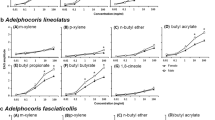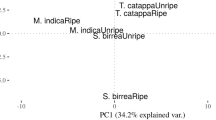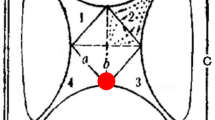Abstract
A steam distillate from the freshly cut young bark of coconut palm Cocos nucifera was analyzed by gas chromatography, combined gas chromatography–electroantennographic detection (GC-EAD) and GC-MS to detect host attractants for the curculionid weevil Rhynchophorus ferrugineus, one of the major coconut pests in Sri Lanka. A twin FID peak consisting of a minor and a major component was shown to possess electrophysiological (EAG) activity. The minor peak was identified as γ-nonanoic lactone 1, while the major peak was identified as 4-hydroxy-3-methoxystyrene 2. In an EAG assay the synthetic racemic nonanoic lactone 1 did not elicit a considerable response in the antenna of R. ferrugineus, whereas the laboratory synthesized 2 showed activity. In a laboratory bioassay using a Y-type olfactometer, synthetic 1 and 2 elicited moderate attractant properties to R. ferrugineus, whereas a 1:1 mixture of the compounds showed increased attraction over that of the individual compounds.
Similar content being viewed by others
REFERENCES
Abraham, V. A., and Kurian, C. 1975. An integrated approach to the control of R. ferrugineus F., the red weevil of coconut palm. 4th Session of the FAO Technical Working Party on Coconut Production, Protection and Processing, Kingston, Jamaica.
Budenberg, W. J., Ndiege, I. O., Karago, F. W., and Hansson, B. S. 1993. Behavioral and electrophysiological responses of the banana weevil, Cosmopolites sordidus to host plant volatiles. J. Chem. Ecol. 19:267–277.
Cardillo, R., Fronza, G., Fuganti, C., Grasselli, P., Nepati, V., Barbeni, M., and Guarda, P. A. 1989. On the mode of conversion of racemic C14-C19 γ-hydroxy alkene fatty acids into C7-C11 optically active γ-lactones in Cladosporium suaveolens. J. Org. Chem. 54:4979–4980.
Chinchilla, C. M., Oehlschlager, A. C., and Gonzales, L. M. 1993. Management of red ring disease in oil palm through pheromone-based trapping of Rhynchophorus palmarum. Proceedings of the International Conference on Oil Palm (PORIM), Kuala Lumpur, Malaysia, September 1993.
CRI (Coconut Research Board). 1971. Leaflet on an electronic device for the detection of red weevil infestations. Sri Lanka.
CRI (Coconut Research Institute). 1975. Report of the Crop Protection Division. Coconut Research Institute (CRI), Sri Lanka. Coconut Q. 26:51–56.
CRI (Coconut Research Institute). 1976. Advisory leaflet, Estate Management and Pest Control, No. 37, Coconut Research Institute, Lunuwila, Sri Lanka.
Dettner, K., and Schwinger, G. 1982. Defensive secretion of three Oxytelinae rove beetles (Coleoptera: Staphylinidae). J. Chem. Ecol. 8:1411–1420.
Dickens, J. C. 1990. Specialized receptor neurons for pheromones and host plant odors in the boll weevil, Anthonomus grandis Boh. (Coleoptera: Curculionidae). Chem. Senses 15:311–331.
Fiddler, W., Doerr, R. C., Wasserman, A. E., and Salay, J. M. 1966. Composition of hickory saw dust smoke. Furans and phenols. J. Agric. Food Chem. 14:659–662.
Gal, S., Windemann, P., and Baumgartner, E. 1976. Study of reactions of coffee beans during steam treatment. Chimia 30:68–71.
Giblin-Davis, R. M., Weissling, T. J., Oehlschlager, A. C., and Gonzales, L. M. 1994. Field response of Rhynchophorus cruentatus F. (Coleoptera: Curculionidae) to its aggregation pheromone and fermenting plant volatiles. Fl. Entomol. 77:164–177.
Gries, G., Gries, R., Perez, A. L., Gonzales, L. M., Pierce, H. D., Jr., Oehlschlager, A. C., Rhainds, M., Zebeyou, M., and Kouame, B. 1994. Ethyl propionate: Synergistic kairomone for African palm weevil, Rhynchophorus phoenicis L. J. Chem. Ecol. 20:889–897.
Griffith, R. 1987. Red ring disease of coconut palm. Plant Dis. 71:193–196.
Gunatilake, R., and Gunawardena, N. E. 1986. Ethyl alcohol: A major attractant of red weevil (Rhynchophorus ferregineus). Proceedings, Sri Lanka Association for the Advancement of Science. 42nd Annual Sessions, p. 70.
Gunawardena, N. E., and Bandarage, U. 1995. 4–Methyl-5–nonanol (ferrugineol), the more attractive component of the aggregation pheromone of the coconut pest, Rhynchophorus ferrugineus F. (Coleoptera: Curculionidae): synthesis and its field use in a preliminary field assay. J. Nat. Sci. Counc. Sri Lanka accepted for publication.
Gunawardena, N. E., and Gunatilake, R. 1993. Preliminary studies on a host attractant of the coconut pest, Rhynchophorus ferrugineus (Coleoptera: Curculionidae). J. Nat. Sci. Counc. Sri Lanka 21:93–101.
Gunawardena, N. E., Attygalle, A. B., and Herath, H. M. W. K. B. 1989. The sex pheromone of the brinjal pest, Leucinodes orbonalis Guenee (Lepidoptera): Problems and perspectives. J. Nat. Sci. Counc. Sri Lanka 17:165–175.
Hagley, E. A. C. 1965. Tests of attractants for the palm weevil. J. Econ. Entomol. 58:1002–1003.
Hallet, R. H., Gries, G., Gries, R., Borden, J. H., Czyzewska, E., Oehlschlager, A. C., Pierce, H. D., Jr., Angerilli, N. P. D., and Rauf, A. 1993. Aggregation pheromones of two Asian palm weevils, Rhynchophorus ferrugineus and R. vulneratus. Naturwissenschaften 80:328–331.
Hruza, D. E., Van Praag, M., and Heinsohn, H. 1974. Isolation and identification of the components of hickory wood smoke. J. Agric. Food Chem. 22:123–126.
Ishiguro, S., Sato, S., Sugawara, S., and Kaburaki, Y. 1976. Studies and composition of smoke components of lamina and midrib cigarettes—Part I. Agric. Biol. Chem. 40:977–982.
JaffeÉ, K., Sanchez, P., Cerda, H., Urdaneta, N., Hernandez, J. V., Guerra, G., JaffÉ., R., Martinez, R., and Miras, B. 1993. Chemical ecology of the palm weevil, Rhynchophorus palmarum: Attraction to host plants and to a male produced aggregation pheromone. J. Chem. Ecol. 19:1703–1719.
Kalshoven, L. G. 1950. Pests on crops in Indonesia (revised and translated by P. A. Van der Laan, 1981). P. T. Ichtiar Baru-Van Hoeve, Jakarta.
MÜller, M., and Haufe, K. 1991. Das Verhalten des großen braunen Rüsselkäfers, Hylobius abietis L. (Coleoptera, Curculionidae), gegenüber Inhaltsstoffen seiner Wirtspflanzen. Arch. Phytopathol. Pflanzenschutz 27:299–306.
Nirula, K. K. 1956. Investigations on the pests of coconut palm. Part IV. Rhynchophorus ferrugineus F. Indian Coconut J. 9:229–247.
Pinto, J. L. J. G. 1984. Red weevil, Pest of coconut. Coconut Bull., Coconut Res. Bd. Sri Lanka 1:36.
Rajapaksha, C., and Kanagaratnam, P. 1988. Further observations on the red weevil pest, Coconut Bull. 5:20–23. Report of the Crop Protection Division (1975), Coconut Q. 26:51–56.
Ravid, U., Silverstein, R. M., and Smith, L. R. 1978. Synthesis of the enantiomers of 4–substituted γ-lactones with known absolute configuration. Tetrahedron Lett. 34:1449–1452.
Reichstein, T. 1932. 4–Oxy-3–methoxystyrol. Helv. Chim. Acta 15:1450–1453.
Rochat, D., Descoins, C., Malosse, C., Zagatti, P., Akamout, P., and Mariau, D. 1993. Ecologie chimique des charancons des palmiers, Rhynchophorus spp. Oleagineux 48:225–236.
Schneider, D. 1957. Elektrophysiologische Untersuchungen von Chemo-und Mechanorezeptoren der Antenne des Seidenspinners, Bombyx mori L. Z. Vergl. Physiol. 40:8–41.
Shaw, P. E., Tatum, J. H., Miyashita, D. H., and Ohinata, K. 1976. Preparation and insect attractant activity of some alkoxy styrene derivatives. J. Agric. Biol. Chem. 24:1186–1189.
Shibata, S., Katsuyama, A., and Noguchi, M. 1978. On the constituents of an essential oil of kudzu. Agric. Biol. Chem. 42:195–197.
Stoll, M., Winter, M., Gautschi, F., Flament, I., and Willhalm, B. 1967. Recherches sur les aromes. Sur l'arome de café. I. Helv. Chim. Acta 50:628–694.
Struble, D. L., and Arn, H. 1984. Combined gas chromatography and electroantennogram recording of insect olfactory responses, pp. 161–178, in H. E. Hummel and T. A. Miller (eds.). Techniques in Pheromone Research. Springer-Verlag, New York.
Tumlinson, J. H., Klein, M. G., Doolitle, R. E., Ladd, T. L., and Proveaux, A. T. 1977. Identification of the female Japanese beetle sex pheromone: Inhibition of male response by an enantiomer. Science 197:789–792.
Viani, R., Bricout, J., Marion, J. P., MÜggler-Chavan, F., Reymond, D., and Egli, R. H. 1969. Sur la composition de l'arome de tomate. Helv. Chim. Acta 52:887–891.
Wattanapongsiri, A. 1966. A revision of genera Rhynchophorus and Dynamis (Coleoptera: Curculionidae), Department of Agriculture Science Bulletin 1, Bangkok, 328 pp.
Weissling, T. J., Giblin-Davis, R. M., Gries, G., Gries, R., Perez, A. L., Pierce, H. D., Jr., and Oehlschlager, A. C. 1994. Aggregation pheromone of Palmetto weevil, Rhynchophorus cruentatus (Coleoptera: Curculionidae). J. Chem. Ecol. 20:505–515.
Wheeler, J. W., Happ, G. M., Araujo, J., and Pasteels, J. M. 1972. γ-Dodecanolactone from rove beetles. Tetrahedron Lett. 46:4635–4639.
Author information
Authors and Affiliations
Rights and permissions
About this article
Cite this article
Gunawardena, N.E., Kern, F., Janssen, E. et al. Host Attractants for Red Weevil, Rhynchophorus ferrugineus: Identification, Electrophysiological Activity, and Laboratory Bioassay. J Chem Ecol 24, 425–437 (1998). https://doi.org/10.1023/A:1022304601123
Issue Date:
DOI: https://doi.org/10.1023/A:1022304601123




